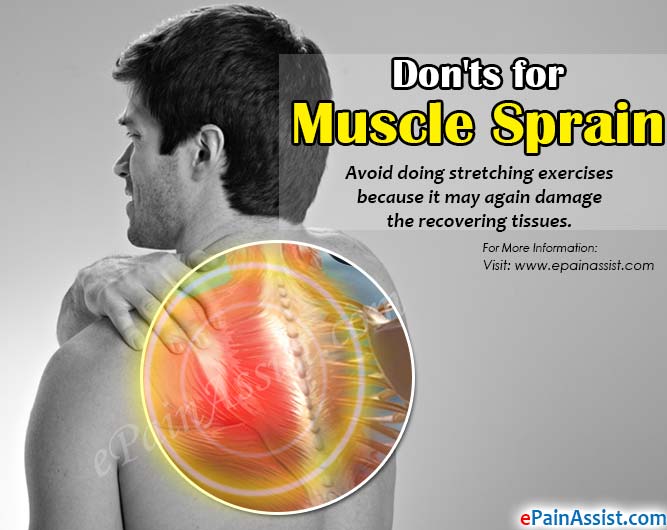About Muscle Sprain
Sprain is a condition where there is tearing or stretching of the ligament that joins the muscles.1 Symptoms of muscle sprain include pain, swelling, bruising, decreased range of motion and instability of the joint.
Serious symptoms of muscle sprain, which require immediate medical attention include:
- Blood oozing out from the injury.
- You are not able to move your leg or arm.
- You can’t walk even after three or four days.
- Injured area of your body becomes completely numb.
Recovery from a sprained muscle depends on the severity and the area of the sprain. Suppose, you have muscle sprain around your ankle joint in leg, then you may not be able to walk for a week or more. There are some do’s and don’ts to follow when you suffer from muscle sprain or strain which can go a long way in speeding up the recovery period.
Do’s for Muscle Sprain
- R.I.C.E:– Rest, Ice, Compression, Elevation is the most effective treatment for treating muscle sprain. R.I.C.E treatment helps in alleviating pain and swelling from the muscle sprain.
- Gentle exercise and pain free movement:– Walk slowly on first day of your injury. Try doing gentle exercises under the guidance of your doctor or physiotherapist to recover from your muscle sprain faster.
- Cross training: –You can start cross training but after complete healing of muscle sprain and without feeling any pain. It shouldn’t be physically heavy since that hinders the chances of recovery. Number of factors include for choosing cross training are easily accessible equipment, personal knowledge and previous experience. Also keep in mind for using low resistance exercises. Internal recovery based program is more effective for proper fitness maintenance.
- Strength training: – Strength training can be done if you feel up to it. Sport movements must be pain free so that you can able to perform all sports action easily. Start your sport action or exercise in supervision of trainer.

Don’ts for Muscle Sprain
- Stretching Exercises: Avoid doing stretching exercises because it may again damage the recovering tissues.
- Power Exercises: These may also damage tissue and lead to swelling of the muscle sprain area. You will suffer more if you get yourself involved in any type of strenuous exercises like heavy weight lifting, sprinting.
- Aggressive Exercises: Do not be hasty in returning to your sports without proper healing of the muscle sprain. Perform simple moving exercises initially so that your muscles get in rhythm. Risk factor for your injury may decrease if you have done simple exercise on a regular basis before starting active sports.

What Leads to Muscle Sprain?
Muscle sprain occurs when your muscle tears at one point due to overstretching. This can happen during any activity. Main causes of muscle sprain are:
- Poor flexibility of joints in the body.
- Unexpected fatigue.
- Poor knowledge regarding physical activities.
Muscle sprain happens when you are:
- Jumping.
- Running.
- Lifting heavy weights.
- Throwing heavy items.
During a physical activity, muscle sprain happens when you suddenly change direction or move for deceleration. Sudden twisting movements of the limbs also result in muscle sprain. Overstretching of the hand may cause wrist sprain. When your foot forcefully turns inwards, then sprain may occur at ankle.
Tips to Prevent Muscle Sprains and Muscle Strains
- Always indulge in any sports activity when you are alert rather than when you are worn out or tired.
- To prevent tripping, run on a flat surface.
- Take healthy diet so that muscles become strong.
- When you are playing sports, always wear protective gear.
- Do simple exercises daily so that your body remains fit and flexible.
- Always maintain good physical condition while playing sports.
- Always warm up before exercising or playing any sports.
Recovery from Muscle Sprain
Recovery just doesn’t mean simply sitting still at home. To attain faster recovery from muscle sprain, use your time in the best possible way. You can use a foam roller to work on the muscular adhesions and spasms. You can also go for icing of the affected area for approximately ten minutes 3-4 times a day. You can also get in touch with your chiropractor, massage therapist or even a yoga instructor. So, during the recovery period, be more alert and conscious of your state and adopt every method to hasten it.
